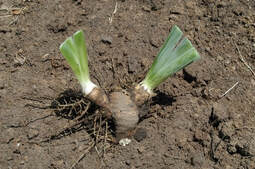
When the bloom season has ended dig the entire plant including all the rhizomes. Break the rhizomes apart by hand at the joints where they are connected. Healthy rhizomes should have roots extending below and a fan of leaf blades above. The rhizome should be at least the width of your thumb and firm. Discard any rhizomes that do not have leaf fans protruding as well as any rhizomes that are soft and have an odor.
Trim the fan blades to about eight-inches cutting each blade at an angle to keep water from collecting in the thick, open leaves. Trimming the leaves prevents the plant from falling over until the roots become established. Dig a shallow hole, deep enough that the top of the rhizome is slightly exposed. Irises will tolerate poor soil conditions but well-drained soil is best. Space plants 12 to 18-inches apart and do not mulch. Irises do not respond well to over-watering; however newly planted rhizomes do need to be watered in thoroughly.
Fertilize according to soil test recommendations or by applying a complete fertilizer, such as a 10-10-10, at the rate of 1 pound per 100 square feet. Mix the fertilizer into the soil to a depth of 6 inches. If your soil test shows high phosphorus levels, use a fertilizer that has a much higher first number (nitrogen) than second (phosphorus). It is important to get irises planted early enough in the season to allow roots to establish before the first hard frost. (Cynthia Domenghini)
 RSS Feed
RSS Feed
